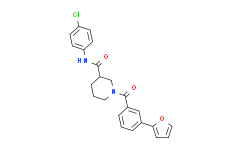| Cas No.: | 1443437-74-8 |
| Chemical Name: | N-(4-Chlorophenyl)-1-(3-(furan-2-yl)benzoyl)piperidine-3-carboxamide |
| Synonyms: | CCG 203971;CCG-203971;N-(4-Chlorophenyl)-1-[3-(2-furanyl)benzoyl]-3-piperidinecarboxamide;N-(4-chlorophenyl)-1-(3-(furan-2-yl)benzoyl)piperidine-3-carboxamide;C23H21ClN2O3;compound 8a [PMID: 23707258];N-(4-chlorophenyl)-1-[3-(furan-2-yl)benzoyl]piperidine-3-carboxamide;CCG203971;GTPL6763;SYN5162;AOB2799;HERLZBNILRVHQN-UHFFFAOYSA-N;BCP20795;BDBM50436236;AK668175;B4921 |
| SMILES: | ClC1C([H])=C([H])C(=C([H])C=1[H])N([H])C(C1([H])C([H])([H])N(C(C2=C([H])C([H])=C([H])C(C3=C([H])C([H])=C([H])O3)=C2[H])=O)C([H])([H])C([H])([H])C1([H])[H])=O |
| Formula: | C23H21ClN2O3 |
| M.Wt: | 408.8774 |
| Sotrage: | 2 years -20°C Powder, 2 weeks 4°C in DMSO, 6 months -80°C in DMSO |
| Description: | CCG-203971 is a second-generation RhoA/myocardin-related transcription factor A (MRTF-A) inhibitor. CCG-203971 potently targets RhoA/C-activated serum response element (SRE)-luciferase (IC50=6.2 μM). |
| In Vivo: | CCG-203971 is tested in a Bleomycin skin injury model. Bleomycin is administered in 50 μL of DMSO intraperitoneally. Preliminary studies show that Bleomycin administered in this manner is well tolerated at 100 mg/kg twice a day. Intradermal Bleomycin for 2 weeks along with the DMSO control (50 μL i.p.) results in marked dermal thickening (P<0.0001) compared with the PBS+DMSO group, which does not receive Bleomycin. CCG-203971 treatment strongly and significantly (P<0.001) suppresses the Bleomycin-induced skin thickening in this model. Skin collagen amounts, assessed by measurement of hydroxyproline content, show similar results. Bleomycin injections promote collagen deposition (P<0.01) and CCG-203971 is able to block this effect (P<0.05)[2]. |
| In Vitro: | CCG-203971, a second-generation Ras homolog gene family, member A (RhoA)/myocardin-related transcription factor A (MRTF-A)/serum response factor (SRF) pathway inhibitor, represses both matrix-stiffness and transforming growth factor beta–mediated fibrogenesis as determined by protein and gene expression in a dose-dependent manner. CCG-203971 significantly represses TGF-β- induced MKL1 expression at 25 μM concentration[1]. Human dermal fibroblasts are plated onto 96-well plates and allowed to grow for 3 days in the presence of 30 μM CCG-203971 or DMSO vehicle. Viable cell density is assessed through enzymatic reduction of the water-soluble tetrazolium dye WST-1. Scleroderma dermal fibroblasts proliferate faster than normal cells, and this is inhibited by CCG-203971[2]. |

 DC Chemicals' products qualify for U.S. tariff exemptions. We guarantee no price increases due to customs duties and maintain stable supply, continuing to deliver reliable research solutions to our American clients.
DC Chemicals' products qualify for U.S. tariff exemptions. We guarantee no price increases due to customs duties and maintain stable supply, continuing to deliver reliable research solutions to our American clients.





















